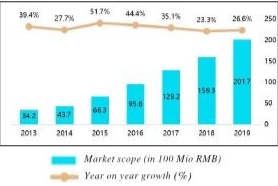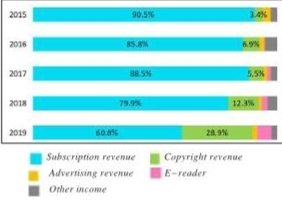By Xiao Dong
On September 4, the China Audio-video and Digital Publishing Association released the 2019 China Online Literature Development Report at the fourth "Online literature+" conference. According to the report, the market scale of online literature will reach 20.17 billion yuan in 2019, with a year-on-year growth of 26.6%.
Since 2013, the market scale of the online literature industry has been rising steadily. In 2015, revenue reached its highest growth rate; in 2019, revenue reached 20.17 billion yuan, this amounts to an increase of 26.6% compared with the year before, although subscription revenue has declined in comparison. Paid for content is still heavily reliant on two factors: the type of subject matter and quality of content.
Revenues generated from rihgts licensing accounted for 28.9%. Apparent key factors to ensure stable growth were the development of copyright cooperation, as well as a continuous improvement of the commercial value of high-quality content in its various forms, such as the adaptation of online literary works into film and TV series, online drama and games. Users’ reading experience has seen further improvement, with AI technology maturing and intelligent speakers and color ink screens making notable appearances. Business models that operate on a combination of different services, as well as the advance of live streaming and short videos increase content visibility and provide for further enrichment of it. The number of online literature works saw a steady growth in 2019, reaching 25.901 million. On average, the time it took to create a work was close to one year, with subject matter of the “urban fiction” genre generating the largest number of clicks. The number of new IP adaptations reached 9,656, and it is especially realistic themes that are popular subject matter when it comes to the adaptation of online literature. There are 19.36 million authors of online literature in China, out of which 770,000 are contracted writers. The number of female authors of online literature has seen a rapid increase, their level of education being mainly university undergraduate and junior college and they are most often based in second and third tier cities. As far as the age structure of the authors is concerned, 44.6% of them were born in the 1990s, with new writers gradually becoming the main force. Companies have been actively searching out topics that are “realistic”, and high quality writing in this respect has emerged in large numbers.
According to the 2020 China Online Literature Overseas Exports Report published at the same time by iResearch, the overseas market scale of China’s online literature has reached 460 million yuan in 2019, and the number of overseas users of Chinese online literature stands at 31.935 million. Southeast Asia and the European and US region are the major geographical areas, with more than 40 “Belt and Road Initiative” countries and regions covered. Looking at the diferent types of export, online literature has made a case for itself by acting as a sort of incubator for works of high quality, actively searching for efective methods of overseas expansion. There are three notable ways of export: translation, direct export and adaptation. Of these, translation is the most widely used method, accounting for 72%. The majority of users can be profiled as middle-aged, mainly reading on mobile devices. They tend to read for comparatively short spans of time, but are nonetheless avid readers. Quality of translation has emerged as the most important challenge as far as the reading experience is concerned.
In the future, apart from expansion achieved via translation, other types of export of online literature will evolve such as the export of technology for content creation, nurturing authors of original content overseas, helping China’s online literature to be present on a wider level via multiple channels. The subject matter of exported content will see a rise in variety, promoting the development of the whole IP industry chain. As for translation technology, AI translation will continue to improve and there will be a variety of languages into which content is translated.
(Translated by Leonie Weidel)




